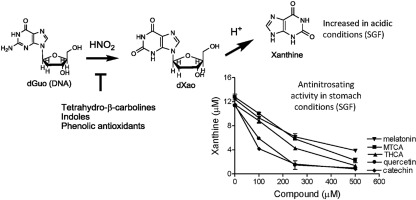Food and Chemical Toxicology ( IF 3.9 ) Pub Date : 2017-12-22 , DOI: 10.1016/j.fct.2017.12.042 Tomás Herraiz , Juan Galisteo

|
Endogenous and dietary nitrite produces reactive nitrogen species (RNS) that react with DNA causing mutations. The nitrosation of 2′-deoxyguanosine (dGuo) and DNA with nitrite was studied under different conditions, and the reaction and degradation products identified and analysed by HPLC-DAD-MS. Nitrosative deamination of dGuo produced xanthine along with 2′-deoxyxanthosine whereas DNA afforded xanthine. Formation of xanthine increased with nitrite concentration and in low pH such as that of stomach. Xanthine was measured as a marker of nitrosation of dGuo and DNA, and it was subsequently used to study the antinitrosating activity of β-carboline alkaloids, and selected antioxidants. Food-occurring tetrahydro-β-carbolines (THβCs) decreased nitrosative deamination of dGuo and DNA under conditions simulating the stomach. Antinitrosating activity was also evidenced for flavonoids (catechin, quercetin) and indole (melatonin) antioxidants. Among THβCs the most active antinitrosating compounds were 1,2,3,4-tetrahydro-β-carboline-3-carboxylic acids (THβC-3-COOHs) that reacted with nitrite to give N-nitroso derivatives as main products along with 3,4-dihydro-β-carboline-3-carboxylic acids and aromatic β-carbolines (norharman and harman). Antinitrosating activity of THβCs correlated well with the formation of N-nitroso-THβC-3-COOHs. These N-nitroso derivatives were stable at pH 7 but degraded in acid conditions affording nitrosating species.
中文翻译:

亚硝酸盐对2'-脱氧鸟苷和DNA进行亚硝化脱氨,β-咔啉生物碱和抗氧化剂的抗亚硝化活性
内源性和饮食中的亚硝酸盐会产生反应性氮素(RNS),与DNA发生反应而引起突变。研究了在不同条件下亚硝酸盐对2'-脱氧鸟苷(dGuo)和DNA的亚硝化作用,并通过HPLC-DAD-MS对反应产物和降解产物进行了鉴定和分析。dGuo的亚硝化脱氨反应产生了黄嘌呤和2'-脱氧黄嘌呤核苷,而DNA则产生了黄嘌呤。黄嘌呤的形成随亚硝酸盐浓度的增加和在低pH(例如胃的pH)下增加。黄嘌呤被用作dGuo和DNA亚硝化的标志物,随后被用于研究β-咔啉生物碱的抗亚硝化活性,并选择了抗氧化剂。在模拟胃的条件下,食物中的四氢-β-咔啉(THβCs)减少了dGuo和DNA的亚硝化脱氨基。黄酮类化合物(儿茶素,槲皮素)和吲哚类(褪黑激素)抗氧化剂也具有抗亚硝化作用。在THβC中,最活跃的抗亚硝化化合物是1,2,3,4-四氢-β-咔啉-3-羧酸(THβC-3-COOHs)与亚硝酸盐反应生成N-亚硝基衍生物与3,4-二氢-β-咔啉-3-羧酸和芳香族β-咔啉(诺曼和哈曼)一起作为主要产物。THβCs的抗亚硝化活性与N-亚硝基-THβC-3-COOHs的形成密切相关。这些N-亚硝基衍生物在pH 7下稳定,但在酸性条件下降解,提供亚硝化物质。









































 京公网安备 11010802027423号
京公网安备 11010802027423号